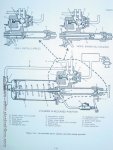808pants
New member
- 45
- 3
- 0
- Location
- Honolulu, HI
I've just pulled apart the second of my two air-packs, both of which failed in that 'where'd my brake fluid GO' way (it was all in the air-cylinder, naturally). I'm not seeing any deals on ebay or elsewhere, and I'm kinda fed up with just putting these piles of parts aside for later anyway, so I'd like to rebuild at least one of them with some confidence that it's not going to do the same thing in short order.
I should already have disclosed that mine's a 5-ton unit - but there doesn't seem to be as much discussion of them over in the 5-ton area. While casting about for solutions, I came across the (reattached) section-drawing of the deuce-type air-pack, and it looks to me like the operation is identical even if the components don't match. So what I am trying to understand is how all that fluid actually gets into the air-cylinder portion of the unit when they go south. I don't think a scored or pitted slave cylinder will do it - that would just let the pedal drift to the floor when it gets really bad, right?
There appear to be two routes:
1) through the armada of seals (on the 5-ton, anyway) that surround the air-cylinder piston-shaft, and
2) via the small "relay piston," through its back-to-back seals or via damage to the bore itself.
Are there other routes?
Again, I don't know the specifics of the internals in the Deuce version of the air-pack, but in both of my failed 5-ton units, I didn't see any obvious bore or seal problems in those locations - (though the slave seals were atrocious on the oldest one, that shouldn't have caused fluid to get into the air-pack, I think.)
If I knew for sure that the problem lies within the relay piston/ or its bore, I would send that housing off to be sleeved, then rebuild the rest after just cleaning things up with a hone and some brakleen. Somewhere else to suspect? Anyone have experience along these lines?
I should already have disclosed that mine's a 5-ton unit - but there doesn't seem to be as much discussion of them over in the 5-ton area. While casting about for solutions, I came across the (reattached) section-drawing of the deuce-type air-pack, and it looks to me like the operation is identical even if the components don't match. So what I am trying to understand is how all that fluid actually gets into the air-cylinder portion of the unit when they go south. I don't think a scored or pitted slave cylinder will do it - that would just let the pedal drift to the floor when it gets really bad, right?
There appear to be two routes:
1) through the armada of seals (on the 5-ton, anyway) that surround the air-cylinder piston-shaft, and
2) via the small "relay piston," through its back-to-back seals or via damage to the bore itself.
Are there other routes?
Again, I don't know the specifics of the internals in the Deuce version of the air-pack, but in both of my failed 5-ton units, I didn't see any obvious bore or seal problems in those locations - (though the slave seals were atrocious on the oldest one, that shouldn't have caused fluid to get into the air-pack, I think.)
If I knew for sure that the problem lies within the relay piston/ or its bore, I would send that housing off to be sleeved, then rebuild the rest after just cleaning things up with a hone and some brakleen. Somewhere else to suspect? Anyone have experience along these lines?
Last edited:




